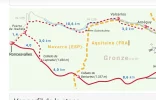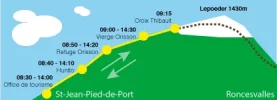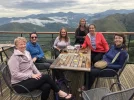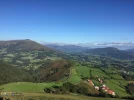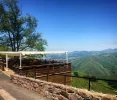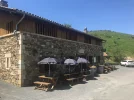Thanks! I hadn't heard of those!
Here is a review I did on Armaskin socks. I would highly recommend that you try them out before committing to using them.
--------------------------------------------------------------
ArmaSkin Socks for Blister Prevention
Entering Blister Discussion Season, there are a couple of reposts of what I had previously written which may be helpful. I will also post my assessment of Engo anti-blister patches later in a separate thread.
First, let me say that I have no vested interest in Armaskin Socks. I have never been in contact with the company that manufactures the product, nor do I have any wholesale or retail or stock market, etc. connections which will earn me cash if someone purchases this product. Buy them or don’t buy them, curse them or praise them, I Don’t Care.
Conclusion and Bottom Line: When used properly, Armaskin Anti-blister Socks can be effective at preventing blisters.
The Specifics
Background
A lot of forum members know that I am hired by various backpacking gear, footwear, and clothing manufacturers to test their products for quality assurance, usability, and the workability of modifications and prototypes. My reports go to the company that has hired me for their internal use; I do not publish reviews, or test stuff to provide public recommendations.
ArmaSkin did not hire me to test their product. Nor did I inform ArmaSkin of my intentions. I purchased the ArmaSkins myself from an online vendor.
I decided to post about Armaskins after recently learning of them. I was curious as to the claims made about them. As a Forum member, I know a lot of others might also be interested in the blister prevention claims, too. There are also some participants who have tried them previously and recommend them.
This post is not a recommendation for or against this product. I am providing the information based on experienced observation, and I make no specific claims that my findings will equally apply to anyone else.
Rationale and Motivation to Test Armaskins
I wanted to know if Armaskin Socks effectively implements the known and effective blister prevention strategies which it appears to incorporate. I also wanted to provide more objective information for those who interested in trying Armaskins but are hesitant to do so because of their price point. It is my hope that having additional information will make the price point less of an issue should one really want to give Armaskins a try but are concerned over cost-benefit.
As a gear tester, I felt I have the skills and objectivity to cut through the hyperbole and marketing claims and look at the individual ‘ingredients’ of these sock’s manufacture for their actual effectiveness toward blister prevention.
Armaskin socks have been around for a while. Until recently, I was not aware of them until a Forum contributor posted a bit of information about them. That post intrigued me, so I did a quick online look about the sock; specifically, what is the makeup of the sock that is special or different which functions to prevent blisters.
After a bit of research, and ignoring the glowing marketing testimonials, I felt like the Armaskins deserved a hands-on look. What got my attention was the fact that, unlike other ‘anti-blister’ socks, this sock incorporated stated and proven techniques to either prevent blisters, or to prolong the time for blister formation to occur. Prolonging the time for blisters to form is also important in preventing blister formation, because it allows more time for a person to recognize the formation of irritations and hotspots on the feet so that they can be effectively dealt with.
What is the big boogeyman of blister formation? Shear force friction. In a nutshell, you want to keep the friction causing heat of the shear force between the sock and the shoe, and away from the sock and the skin. Do this and there will be no blistering in 99.9% of all cases.
It appears that Armaskins accomplish this goal in three primary ways:
- A snug fit of the sock.
- A sock material which reduces the coefficient of friction.
- Providing a material buffer between the shear friction force and the skin of the foot.
Gear Test
The socks are made of a slick feeling synthetic material, with a defined seamed area at the toes and the heel. More on the seams later. Applied to the interior of the sock is a flexible, durable, and grippy rubbery-type compound. It is a silicone-based menu of stuff, but it is inert and is said to be breathable.
There are four basic sock sizes. One picks the Armaskin sock size based on their sizing chart; the sizing chart utilizes your sock size to determine if you need a Small, Medium, Large, or Extra-Large size. As with some others whose review had stated that the Armaskin Chart guide selections were too small, I had to go with a Large, rather than the Medium that the Chart said I needed. I had purchased two pair, one in the size the Chart indicated was my size, and the other was a size larger. I ended up returning the Medium sized sock.
Each of the socks in the pair have a defined shape to them --- when looking at them, it is easy to see which sock is for the right foot and which for the left. I experimented putting them on in the dark, and it was simple for me to feel the shape of each sock, so the proper match would be made to the foot in question.
My technique for putting the sock on was to scrunch the top of the sock down to the toe. Then, once my toes were successfully ensconced, I would roll-tug them up, over the heel and up to final position. I always made additional adjustments to getting things properly aligned. With my foot size, the required sized sock which fit, had the heel location up above the back of my heel onto the lower part of my Achilles tendon. It couldn’t be helped, it was just the way it was.
Important Note: If you are a user of a lubricating medium on your feet to help prevent blisters -- like Body Glide or Vaseline, etc. – you
cannot use such things with Armaskin socks; such stuff will make the socks ineffective.
Even with a larger size Armaskin, the fit is very snug. My initial reaction was concern that the amount of compression on my foot would create problems with hours of wear. For me, such turned out not to be the case. I can understand where it would be possible for some folks to find this level of snugness objectionable, and even constricting enough of blood circulation in the foot to cause cramping or other discomforts. In my case, none of those issue appeared.
Once on, the Armaskins do not slip or really move around on the foot. The snugness and the ‘grippy-ness’ keep things in place. This is one of the reasons it is important to have the sock lay smooth on the foot with no lumps or rucks of material; get the sock smooth and it will stay that way.
Here is where the Armaskin Socks are not really a liner sock, or a part of a dual sock system in the traditional sense. With the old-school technique, the traditional use of a thin liner sock is used under a thicker sock as a system to try and prevent blisters. The Armaskin does not
need an outer sock to prevent blisters; it only needs the outer sock to protect the Armaskin from premature wear and tear. Thus, it is not a "double-sock liner system".
If one does not care how long their Armaskin Socks will last, you can wear the Armaskin by itself and will still do the job it was designed to do. The Armaskin, by itself, will keep the shear force’s blister-causing friction from the skin on the foot, and keep it between the Armaskin and the shoe where it belongs.
I spent over 160 miles hiking in all sorts of backpacking terrain, under all sorts of backpack weights, using the Armaskin in a variety of shoe and insole combinations, using them with and without an outer sock, and subjected to all kinds of dirt, grit, mud and wet. I never really felt at-risk of getting blisters. One caveat, though, as a full disclosure: It is unusual for me to blister.
That being said, I
have gotten blisters before and I do, infrequently, deal with hotspots and recognize the conditions which put me at-risk for developing those hot spots. I took great pains to recreate those kinds of conditions with gusto.
Many users posting reviews have stated that the Armaskins didn’t make their feet warm or hot. All I can say is that my feet did get warmer, sometimes much warmer, than with my usual socks and footwear combination. I typically will wear a single, lightweight and light padded Merino wool sock. Being much warmer wearing a double sock combination with the Armaskin didn’t surprise me, though. I will note that my feet also did become a bit damp from sweat a few times; while the Armaskin may claim to be breathable, that breathability is restricted to the ability of airflow within a shoe. Wearing an outer sock and being in the confines of a shoe means that there must be an overall decrease in the ability of water vapor to escape.
The Armaskins never got ‘funky’ smelling. They washed well; the washing would ‘renew’ the 'grippy-ness’ of the sock's interior coating, probably because washing removes body oils, dirt, skin cells, etc. Just be sure to carefully follow the manufacturer’s washing instructions. Because of the Camino application, I washed these Armaskins by hand in cool water, with just barely enough soap to get them clean. The soap I used is what I used on Camino. The socks wring out fairly well and do not take overly long to dry. To help preserve the materials and longevity in the socks, I would not dry them in the harshness of direct sunlight… that much UV radiation will affect the synthetic materials, as will the high heat of direct radiant energy. If using a dryer, I would air dry as a preference; or at most, the lowest heat setting possible.
End of the day comfort? I always enjoyed removing the socks and letting my feet out of the snugness factor of the Armaskins. While they were on, though, I never had my attention focused on my feet and I never felt that my feet were distressed at all. Even my persnickety Left Foot – who hates me with its entire being – kept quite about the socks.
Are Armaskin Socks the
best method, or the
surest method, for blister prevention? In my assessments,
no. Armaskins are potentially just one method, among others, which
can be effective. As with everything gear related, there can be some downsides, and they
are a bit finicky. I don’t think that should keep potential users from trying them out, though.
If someone:
- Uses the socks as directed
- Takes care of them
- Does not put absolute trust in them by ignoring the need to stay focused on potential hot-spots and other indications of blistering so they can be dealt with before a blister appears:
then I think that the Armaskins may work well.
NOTE:
The same principles which Armaskins use to prevent the shear force friction which causes blistering has existed prior to Armaskins. The materials and techniques to achieve this are cheaper to employ, more flexible and adaptable to unique situations by targeting the specific problem areas on the feet, and are easier to obtain if replacement is necessary.
So, for what it’s worth that is my assessment of Armaskins. It is my hope that this informs the group of another tool for potential blister prevention.









